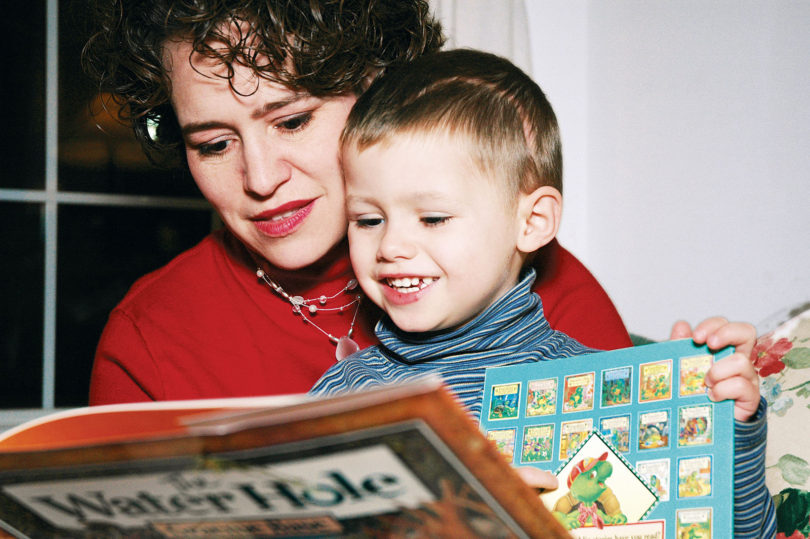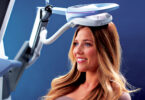One week before Christmas in 2004, as many children across our community counted down the days until Santa’s arrival, one local couple — Jordi and Andrea Catasus-Greathouse — began a search for the ultimate Christmas gift for their 2-year-old son Sebastian. What they sought wasn’t a bright shiny tricycle, or a toy train, or a colorful set of building blocks to place next to their Christmas tree. What they wanted most wasn’t sold in any store. What they wanted most was a cure. They had just received news that could bring the bravest of parents to their knees. In less than a week, a seemingly routine diagnosis of strep throat had changed to a diagnosis of brain cancer and a sizable, aggressive brain tumor.
On a Monday morning early that December, Sebastian Catasus awoke vomiting and saying that his head hurt. Andrea took him to the Pediatric Associates of Williamsburg, where a nurse practitioner, after observing redness in Sebastian’s throat, gave him a strep test that came out positive. She prescribed an antibiotic, and by the next afternoon, he seemed to be improving. The next morning Andrea made a second trip to the doctor’s office; Sebastian’s older brother Xavier had fallen ill as well, but Andrea remained particularly concerned about Sebastian. The previous afternoon he had been running and playing, but again that morning he was vomiting. Andrea, who had been an engineer before having children, was determined to get her questions answered. She had researched strep throat online, learning that Sebastian’s symptoms were possible with strep, but still she was not satisfied. That day in the pediatrics office, they saw Dr. Mark Downey, who was also a close friend of their family. He agreed with the nurse practitioner’s diagnosis, but the next day Andrea and Sebastian were in his office again, this time because Sebastian said light was hurting his eyes. Downey acknowledged that a viral illness, perhaps a mild form of meningitis, might have developed alongside strep. He advised Andrea to have Sebastian complete the antibiotic but told her to call if his condition did not improve.
By Friday, Sebastian was so sick he could barely lift his head from his pillow. “He was pitiful,” Andrea remembers. That day, after Xavier became ill at school, she picked him up and returned to the pediatrician’s office with both boys. Sebastian had clearly taken a turn for the worse, and Andrea could not rest until she got a diagnosis that explained Sebastian’s condition. When she called Downey’s office to say she was on her way, there were no appointments available for Sebastian. Andrea told the receptionist, “I am bringing him now.”
Normally level-headed and calm, Andrea was distraught by then, ransacking her memory for possible causes of Sebastian’s worsening condition. When Downey learned that Andrea was bringing Sebastian in with much more serious symptoms, he called her while she was en route. She told him that Sebastian had fallen out of bed the week before, so he thought a concussion might account for some of Sebastian’s symptoms. He told Andrea to go straight to the emergency room at Sentara Williamsburg Community Hospital. There Sebastian was to receive a CT scan of his head and a spinal tap to check for viral meningitis. Jordi met Andrea at the ER and took Xavier home, so Andrea found herself alone, waiting for the results of the CT scan. When a doctor and two nurses entered the room, she knew she was in trouble.
Moments before, Downey had received a call he may never forget: radiologists in the ER had diagnosed Sebastian with a large brain tumor. Downey remembers, “My first thought was, ‘You’re joking, right?’ ” He immediately rushed to the ER, hoping to arrive in time to tell Andrea the news himself. Downey didn’t arrive soon enough, but instead, Andrea says, “he got to be my hero and let me collapse on him.”
Jordi returned to the ER, and both parents struggled with disbelief: “We’re both engineers,” Andrea says. “We kept having to look at the scan.”
When at last Jordi and Andrea had a moment alone at the hospital, she said to him, “We will donate his organs, won’t we?” Perhaps premature, the comment seems now, but at the time, she says, “I was sure he was going to die.”
Sebastian needed emergency surgery. The tumor was placing dangerous pressure on his brain, and as a result, his brain had shifted out of proper alignment in his skull. Sebastian would have to travel via ambulance to the nearest pediatric neurosurgeon. Downey got on the phone and found that Dr. John Ward at MCV Hospitals in Richmond could perform the surgery.
During the harrowing two days before the operation, Sebastian screamed out in pain. Nurses struggled with him as he tried repeatedly to pull out the IV tubes for his painkillers. Unable to relieve his agony, Andrea found herself helpless and in tears. She remembers, “It was pure hell.”
The surgery went surprisingly well, and Ward was able to remove all traces of the tumor. The days that followed, however, were daunting, as Sebastian required weeks of radiation to prevent regrowth of the tumor. The tumor was diagnosed as a brain cancer, anaplastic ependymoma, a type of tumor that can spread quickly, becoming difficult to treat. Such tumors are typically treated with radiation, and Andrea and Jordi chose to consult doctors at Children’s Hospital of the King’s Daughters in Norfolk, since CHKD specializes in treating children. There Sebastian was to begin six weeks of radiation, but his doctors weren’t convinced the first tumor diagnosis was correct. They concluded, after consulting with experts at other research hospitals, that the brain tumor was instead a type known as AT/RT, shorthand for atypical teratoid rhabdoid tumor. An even rarer and more aggressive brain cancer than the earlier diagnosis, AT/RT carried, according to Downey, “an even more dismal prognosis for a child so young.” Not one of the doctors the family talked to knew of a child with AT/RT who had survived through treatment.
Back in Williamsburg, Downey got on the phone again, calling hospitals to try to determine the best next step for his friends. He suggested St. Jude’s, the nationally renowned research hospital in Memphis, Tenn. The hospital is well-known for providing cutting-edge treatment for children with the rarest and most dangerous cancers. Amazingly, thanks to St. Jude’s numerous grants and fund-raising efforts, the hospital provides this top-quality care at no cost above that covered by a patient’s health insurance. However, in order for a patient to be accepted at St. Jude’s, the hospital must have an on-going study of the patient’s disease. St. Jude’s was studying AT/RT, and its brain tumor physicians agreed to take Sebastian as a patient if he and his family could come to St. Jude’s immediately. Says Andrea, “They wanted us to pack for a month and come that afternoon.”
When the Catasus family returned home from Norfolk to pack for Memphis, a group of their friends awaited them. “They just took care of everything,” Andrea says. “I was thinking, ‘I’m leaving for a month with a child that I’m probably not coming home with,’ and I couldn’t think.” One friend sat with her to help her pack. Very calmly, her friend began: “You’re going for a month. You’ll need socks.”
The decision to bring Sebastian to St. Jude’s was the beginning of a long and painful separation for their family. Both parents agreed that Andrea should stay with Sebastian, who would need her almost round-the-clock, and Jordi would remain at home, so Xavier could stay at his school.
Despite the life-threatening illnesses treated at St. Jude’s, the hospital exuded a remarkably positive, even playful, atmosphere. “I never got the feeling that it was a research hospital,” Jordi says. “From the drivers who pick you up at the airport, to the receptionists at the facilities where families stay, to the [medical] staff, everyone was friendly, understanding and very approachable.”
That easygoing atmosphere, along with the comfortable accommodations, helped ease the stress of the formidable brain cancer treatment schedule that faced Sebastian and his mom: 10 weeks of chemotherapy, six weeks of radiation, a four-week break with no treatment, then a final intense period of chemotherapy for 20 weeks, possibly as many as 30.
The brain cancer treatments carried with them a nightmarish assortment of possible side effects. Sebastian struggled with the common side effects of vomiting and hair loss, and he also repeatedly experienced one lesser known peril of chemotherapy — neutropenia, a condition in which white blood cell counts drop dangerously low. This put him at risk of contracting a life-threatening infection. If Sebastian for any reason developed a fever at the same time, he was admitted as an inpatient, monitored closely and treated with antibiotics. At these times, Andrea had to give him a fiercely painful injection every day to elevate his white cell count. “I had to wrestle him down and stab him with it,” she says. “It was horrible.”
The chemotherapy also carried alarming long-term risks such as the possibility of hearing loss, and the radiation could reduce a patient’s IQ by 10 to 20 points.
In weighing the risks and benefits of the brain cancer treatment, Andrea and Jordi had to “make some horrible, horrible decisions,” she says.
Sometimes for days and nights on end, Sebastian and his mom barely slept; he vomited often from chemotherapy, and medical staff entered his room every few hours to check his urine and vital signs. At the worst times, Andrea could scarcely leave his bedside to get food or take a shower. But despite her exhaustion, she kept meticulous records of Sebastian’s medications, dosages, tests and their results. She marshaled all her strength to achieve a single goal —to be sure Sebastian received the best care St. Jude’s could provide.
Back home in Williamsburg, Downey’s wife Kristin helped Jordi set up a website to inform family and friends about Sebastian’s condition and provide Andrea with an outlet for her emotions. The website also provided an opportunity to thank the countless people who supported the family. At home, friends took care of Xavier after school, walked the family’s dog, decorated their home for every season. At King of Glory Lutheran Preschool, which Sebastian had attended, Director Ruth McReynolds and other preschoolers’ parents encouraged prayer and fundraising support and coordinated gifts of frequent flier miles.
Sebastian’s brain tumor had been diagnosed more quickly than most, Andrea learned at St. Jude’s. She attributes that unusual speed to “a combination of a mother’s intuition and a doctor [Downey ] who trusted me.” Of Downey and the other doctors who led the family to the diagnosis, Andrea says, “I think they were right on track.” It also didn’t hurt, she says, that her “mother’s instinct had never kicked in that quickly.”
In the family’s entries on their website, the second half of 2005 portrayed a brightening picture. The end of treatment seemed within sight, and as Sebastian’s periodic MRIs continued to show no regrowth of cancer, his parents began calling their son’s progress a “miracle.” By late August Sebastian was rebounding surprisingly, his energy returning after a brutal period of chemotherapy. On September 1, Jordi wrote triumphantly that Sebastian’s latest brain MRI was — astonishingly – still clean, with no sign of AT/RT. A few days later, they announced that his doctors had decided to shorten his final round of chemotherapy. On Oct. 13, Andrea wrote, “We are going home!!”
The following Saturday, after bidding farewell to their St. Jude’s “family,” she and Sebastian were on a plane heading home. Here in Williamsburg, they began re-establishing a normal routine, reuniting with friends, rediscovering themselves as a family with Jordi and Xavier. They enjoyed simple pleasures, like carving pumpkins at a Halloween party, and seeing Sebastian return joyfully to his preschool for the first time. In mid-November the family sighed with relief after a final “clean” scan at St. Jude’s. They returned home hoping for continued good luck on future scans every three months, but deeply thankful for Sebastian’s amazing success so far, and for the overwhelming support they had received from friends, family and people they had never met.
At their home this past December, Andrea and her boys seemed remarkably typical of a young family. In their living room, family photos adorned the top of a bookcase, and their decorated Christmas tree shone with lights. At the coffee table, Sebastian switched on a Thomas the Train toy, and he watched in delight as the cars noisily raced around the tracks. Later, the boys played in their playroom, where plastic bins were filled with toys, an alphabet poster hung on one wall, a bulletin board overflowed with the children’s artwork, and a fish tank bubbled in one corner. Meanwhile, the family’s new kitten wriggled on the floor.
“In my mind,” Andrea says, “Sebastian is on his way to becoming a survivor. We just had this huge network of people praying for him. I said to Ruth [McReynolds], ‘When you lean in close to Sebastian, you can feel the angels circling him.’”
Originally published January 2006.




